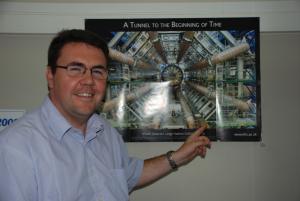Used to large scales: Arnaud Foussat
He is used to thinking in big dimensions and to working in an international environment. The fact that he used to be a rugby player is most certainly not a handicap: Arnaud Foussat, a material science engineer and a graduate of the National Institute of Applied Science in Toulouse, is one part of the two-man-team (besides Paul Libeyre) in charge of ITER's central solenoid and the correction coils. He joined the ITER Organization in May 2008 after having worked on high pulsed power electrical technology in Basel and with Oxford Instruments developing Quench protection systems on magnets in Oxford. The last 10 years he spent at CERN constructing ATLAS Toroidal magnets, one of the huge detectors magnet system on the Large Hadron Collider (LHC). Arnaud has been part of the ATLAS project right from its beginning, the cavern excavation, until the final commissioning magnet test. So he knows all about the ups and downs of a big science project.
"Talking about ITER's central solenoid, the magnet is still on paper", Arnaud says. "But sooner or later we will start manufacturing and finally assembling towards its commissioning. Then, I am sure, we will have to face many technical issues, big and small,, as well as the odd last minute repairs." At this point the team player enters the game: "From my former experience at CERN I know that some of the problems that arise when building these big systems are too complex for one man, one team or even one party alone. That will really be the time to play and interact between teams."
Comparing ATLAS and ITER, there are many similarities—and differences.
"Although ITER operates on a larger scale—and that is not only with regard to the magnets' size and energy capacity—the project's functionalities and its technological challenges are very similar", Arnaud admits. The word "cost cut" is also not new to his ears. "We had to cut the costs for ATLAS by one third which we did, for example, by implementing value engineering tools at each stage of the project. So, the phase we are going through right now with a profound review of the estimated costs for ITER is a very natural process in large science projects."
At ATLAS, a system of four magnets provides the magnetic field for the inner detector, the solenoid, and the muon detectors, the toroids. There are eight so—called Barrel Toroid (BT) Coils on ATLAS with conductors made of NbTi. These BT Coils are currently the largest superconducting magnets in the world.
ITER: 18 TF coils, Nb3Sn conductor, 8,7 m wide x 13,8 m high, 810 ton superconductor, TF coil weight: 6540 tons, 81 km conductor, Force per TF coil: 403 MN, Current: 68 kA at 11.8 T, Energy in TF coils: 41 GJ, Construction: 10 years
ATLAS: 8 BT Coils, NbTi conductor, 20 m diam. x 25 m long, 170 ton superconductor, BT coil weight: 1320 tons, 90 km conductor, Force per BT coil: 15 MN, Current: 20.5 kA at 4.1 T, Energy in BT coils: 1.55 GJ, Construction: 8 years


